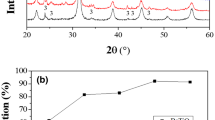Abstract
The effects of the barium/titanium (Ba/Ti) ratio on the crystalline phase, Curie temperature, and dielectric properties of solid-state-reacted BaTiO3 powder were investigated. The experimental results showed that tetragonality decreased and the Curie temperature shifted to lower temperature when the Ba/Ti ratio strayed from 1.0. The BaTiO3 powder had the maximum dielectric constant when the Ba/Ti approaching 1.0.









Similar content being viewed by others
References
Y.H. Hu, M.P. Harmer, and D.M. Smyth: Solubility of BaO in BaTiO3. J. Am. Ceram. Soc. 68, 372–376 (1985).
S. Lee, C.A. Randall, and Z.K. Liu: Modified phase diagram for the barium oxide-titanium dioxide system for the ferroelectric barium titanate. J. Am. Ceram. Soc. 90, 2589–2594 (2007).
P. Abelard: Ceramic Materials: Processes, Properties and Applications (ISTE, London, 2007), pp. 98–130.
L.C. Dufour, C. Monty, and G.P. Ervas: Surfaces and Interfaces of Ceramic (Materials Kluwer Academic, Boston, MA, 1989), pp. 521-533.
K. Uchino, E. Sadanaga, and T. Hirose: Dependence of the crystal structure on particle size in barium titanate. J. Am. Ceram. Soc. 72, 1555–1558 (1989).
B.D. Begg, E.R. Vance, and J. Nowotny: Effect of particle size on the room-temperature crystal structure of barium titanate. J. Am. Ceram. Soc. 11, 3186–3192 (1994).
J.D. Freire and R.S. Katiyar: Lattice dynamics of crystals with tetragonal BaTiO3 structure. Phys. Rev. B: Condens. Matter 37, 2074–2085 (1988).
L.K. Templeton and J.A. Pask: Formation of BaTiO3 from BaCO3 and TiO2 in air and in CO2. J. Am. Ceram. Soc. 42, 212–216 (1959).
K.H. Feigner, T. Muller, H.T. Langhammer, and H.P. Abicht: On the formation of BaTiO3 from BaCO3 and TiO2 by microwave and conventional heating. Mater. Lett. 58, 1943–1947 (2004).
N.M. Hwang, S.H. Yoon, J.H. Lee, and D.Y. Kim: Effect of the liquid-phase characteristic on the microstructures and dielectric properties of donor- (niobium) and acceptor- (magnesium) doped barium titanate. J. Am. Ceram. Soc. 86, 88–92 (2003).
J.K. Lee, K.S. Hong, and J.W. Jang: Roles of Ba/Ti ratios in the dielectric properties of BaTiO3 ceramics. J. Am. Ceram. Soc. 84, 2001–2006 (2001).
P.K. Dutta, P.K. Gallagher, and J. Twu: Raman spectroscopic and thermoanalytical studies of the reaction of Ba(OH)2 with anatase and titanium oxide gels. Chem. Mater. 4, 847–851 (1992).
G. Arlt, D. Hennings, and G. de With: Dielectric properties of finegrained barium titanate ceramics. J. Appl. Phys. 58, 1619–1625 (1985).
C.Y. Huang: Thermal expansion behavior of sodium zirconium phosphate structure type materials. Ph.D. Thesis, The Pennsylvania State University, University Park, PA, 1990.
H.G. Lee and H.G. Kim: Ceramic particle size dependence of dielectric and piezoelectric properties of pizeoelectric ceramic-polymer composition. J. Appl. Phys. 67, 2024–2028 (1990).
V. Petrovsky, A. Manohar, and F. Dogan: Dielectric constant of particles determined by impedance spectroscopy. J. Appl. Phys. 100, 014102 (2006).
V. Petrovsky, T. Petrovsky, S. Kamlapurkar, and F. Dogan: Characterization of dielectric particles by impedance spectroscopy (Part I). J. Am. Ceram. Soc. 91, 1814–1816 (2008).
V. Petrovsky, T. Petrovsky, S. Kamlapurkar, and F. Dogan: Physical modeling and electrodynamic characterization of dielectric slurries by impedance spectroscopy (Part II). J. Am. Ceram. Soc. 91, 1817–1819 (2008).
V. Petrovsky, T. Petrovsky, S. Kamlapurkar, and F. Dogan: Dielectric constant of barium titanate powders near Curie temperature. J. Am. Ceram. Soc. 91, 3590–3592 (2008).
Acknowledgment
This work was supported by the National Science Council, under Grant No. NSC100-2221-E-006-134-MY3.
Author information
Authors and Affiliations
Corresponding author
Additional information
Address all correspondence to this author
Rights and permissions
About this article
Cite this article
Chang, CY., Wang, RL. & Huang, CY. Effects of Ba/Ti ratio on tetragonality, Curie temperature, and dielectric properties of solid-state-reacted BaTiO3 powder. Journal of Materials Research 27, 2937–2942 (2012). https://doi.org/10.1557/jmr.2012.318
Received:
Accepted:
Published:
Issue Date:
DOI: https://doi.org/10.1557/jmr.2012.318




